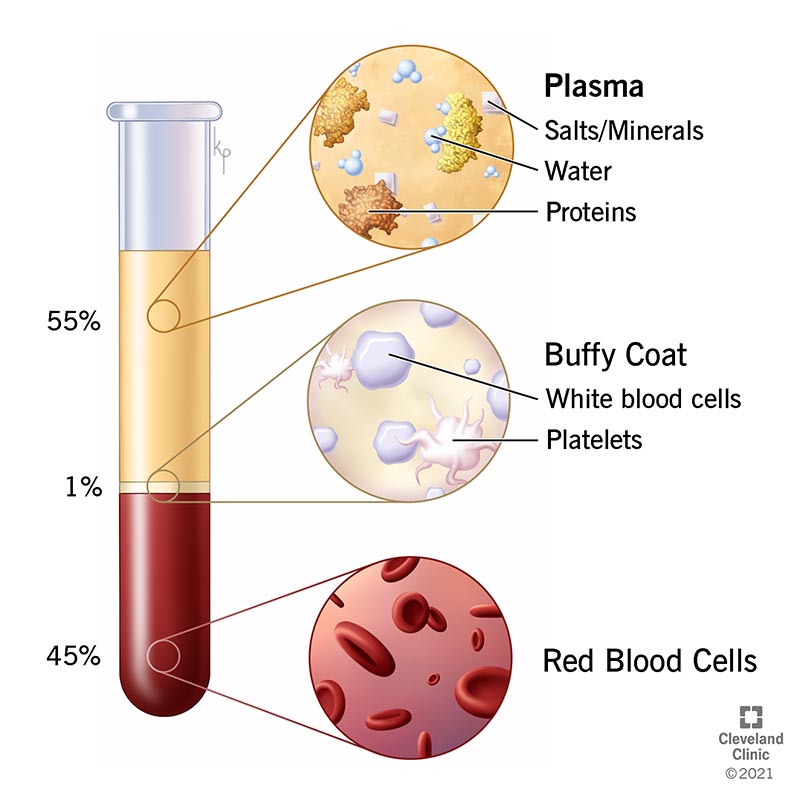Blood flows like a liquid because of plasma. And that isn’t the only thing that makes it important. Plasma also carries proteins and chemical compounds that keep you alive and your body working properly. You can also donate plasma, and it can be used to help others in a variety of ways.
Advertisement
Cleveland Clinic is a non-profit academic medical center. Advertising on our site helps support our mission. We do not endorse non-Cleveland Clinic products or services. Policy

Plasma is the liquid part of your blood. This fluid makes up a little over half of your blood’s total volume. Other blood cells — like red blood cells, white blood cells and platelets — mix in with the plasma, which carries them to every corner of your body.
Advertisement
Cleveland Clinic is a non-profit academic medical center. Advertising on our site helps support our mission. We do not endorse non-Cleveland Clinic products or services. Policy
Plasma is about 92% water. Proteins (antibodies, coagulation factors, albumin and fibrinogen) make up another 7% of it. The other 1% is hormones, vitamins, water, salt, enzymes and other important compounds.
Plasma has several jobs that make it vital to your survival:
Think of plasma like a river, and everything it carries like boats. Without enough plasma, it’s like a river with a water level that’s too low. It can’t flow or carry those boats — and their vital cargo —where they need to go.
Plasma doesn’t really come from a specific place. Instead, it forms when water in your body combines with electrolytes you absorb through your digestive tract. Some of the important proteins that go into plasma come from specific organs or places, though. They include your:
Advertisement
Once those proteins combine with the electrolyte-rich liquid, you have plasma.
Plasma is a pale, yellowish or straw-colored liquid when you separate it from red blood cells, white blood cells and platelets.
Your plasma can be different colors if you have a condition that affects what’s in the plasma. For example, if you have red blood cells breaking down (hemolysis), your plasma might look pinkish. If you have high bilirubin levels and jaundice from a liver condition, your plasma may look greenish or brownish.
In general, your blood is about 55% plasma. That number can vary a little, depending on your sex or medical conditions you have.
You can separate blood components, including plasma, using a tool called a centrifuge. This machine spins a tube full of blood very fast. That creates a gravity-like effect that pulls heavier red blood cells to the bottom of the tube. Atop the red blood cells is a whitish layer of platelets and white blood cells. And above that whitish layer is the plasma.
Plasma contains several proteins, including:
Yes, donated plasma goes through testing for diseases like:
Many conditions and diseases affect your plasma. Some examples include:
Some symptoms that can indicate a plasma condition or related issue include:
Several blood tests can check your plasma for signs of a medical condition. Some of these include:
The treatments for plasma disorders depend mainly on the disorders themselves. Some examples of treatments include:
Advertisement
There are two ways that you can donate plasma:
After removing plasma from your body, the lab freezes your donated plasma within 24 hours. That preserves clotting factors and immunoglobulins. Frozen plasma has a shelf life of one year.
Plasma from donors with an AB blood type is preferred because it doesn’t have antibodies in it. That means people with any blood type can receive it. But anyone can still donate plasma and help others.
Donated plasma may see any number of uses. Some examples include:
Advertisement
Plasma might be mostly water, but it’s still one of the most essential substances in your body. It’s what gives your blood the ability to flow as a liquid, and it carries everything that your cells need to survive. You can also donate it to benefit others. Routine blood tests that are part of an annual wellness exam can detect plasma-related issues. And those tests can usually find issues before you have symptoms.
If you have questions about how your plasma affects your health, talk to your healthcare provider. They can tell you more and help you make health decisions that your plasma could impact.
Advertisement
Cleveland Clinic’s primary care providers offer lifelong medical care. From sinus infections and high blood pressure to preventive screening, we’re here for you.

Last reviewed on 03/13/2025.
Learn more about the Health Library and our editorial process.